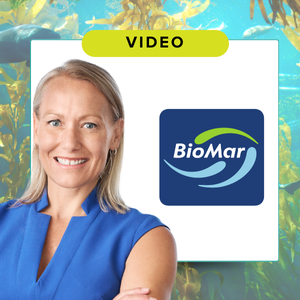Video Interview: 6 mins with Biomar's Katherine Bryar

Hear from Katherine Bryar, Global Marketing Director at Biomar on why cross-sectoral collaboration is more important than ever to drive transformation across the blue economy.
Read the full transcript below:
Callum Broadley So, hello. I'm Callum Broadley, Partnerships Manager for the Blue Food Innovation Summit taking place in London this April on the 8th and 9th. I'm delighted to be joined by Katherine Bryar, Global Marketing Director of Biomar. Welcome, Katherine. Katherine Bryar Thank you, Callum. Callum Broadley It's great to be speaking to you ahead of the summit. Let's dive in. Why are cross value chain collaborations crucial for driving systemic change in aquaculture? How has Biomar built successful strategic innovation partnerships and what factors contribute to their effectiveness? Katherine Bryar Well, if we as an industry, if we are all working together on a common purpose, then we're able to bring change fast to the industry. So we have in in Biomar looked at value chain collaborations, which means looking at everyone from a raw material supplier right through to a retailer and we've come together on the table. And to find what the parameters look like before we get going. So if we are all aligned before we start on an innovation project, then it's going to be faster to get to adoption and get greater buy in. So we've had extreme success in this over the last 10 years and it's kind of for us being some of the foundation of of our success. Callum Broadley Fantastic. Amazing. And why must novel ingredients demonstrate clear value beyond merely serving as replacements? What strategies does Biomar employ to ensure new ingredients match or surpass the nutritional benefits of conventional alternatives? Katherine Bryar OK, so you know, traditionally the diet of a farmed fish or shrimp is predominantly marine ingredients, which of course makes sense. Fish eat fish in the wild. But when we get to that situation where we were overfishing. We couldn't take those resources and then feed them to other species. We had to if we were really going to provide blue foods to our growing population. We had to do it in a better, more sustainable way and in that way we started to look at the feed ingredients because that is where the majority of the impact lies, around 80%, We first moved from marine ingredients to produce to primarily plant-based ingredients in the diets around 80% of the diet became plant based and only 20 marine. So that's kind of where we are at the moment. But to go to the next stage of innovation, we should be coupling from plant ingredients that otherwise could be destined for the human supply chain so that we have more circularity and in that way we're looking for circular ingredients, those that are by-products from the human supply chain. Or we're looking at alternative ingredients that are something that where we can go down to single cell microorganisms and build up our recipes from that point of view. So these things cannot be directly just replaced. First of all, we look for proteins and we look for omega-3s and these basic EPA DHA lipids and so forth. And one is to get a direct replacement. But if that what you're replacing has a cheaper price point than when you're coming into the market, you're now in a commodity situation where price and volume kind of matters. So if you're able to prove either benefit on a functional benefit for fish health and welfare, or a lower environmental impact. These are going to be able to have a greater value than just the core nutritional profile that it comes from. So having ingredients that are most likely going to be at a higher price price point need to deliver a higher value. In other parameters and when we get these kinds of things, you know this is how we're able to bring them to market. Callum Broadley That's amazing. And finally, we're also working together to spotlight women leadership in aquaculture and seafood. Katherine, as a leader in the blue economy, why do you think it's important to celebrate and elevate women in the blue value chain? Katherine Bryar Firstly I believe that inclusion, whether it's gender or culture or any other diversity parameter, allows us to bring different perspectives to the to the table. So that's that's all good. But we're in a situation in, in the aquaculture industry where 50% of the industry is women. Yet very few of those attend conferences as leaders. [Participation] last year was quite good. It was around 30% according to the SAGE Organisation. But the year before it was only 19%. So you know with 50% of the industry being women, we would like to have that equal percentage showcase at events like the Blue Food Summit. So, a way of doing this is in encouraging women to Speak up, present their work and feel empowered, to come, to come to the table, and how best to do that well. When women come together in one room? It's a different kind of energy. It's based on collaboration and support where we support and uplift each other, where women feel more comfortable to talk without judgement. So coming together for the breakfast, it's only an hour, but coming together for the breakfast, where we're able to speak freely, share and celebrate each other. We hope that lifts their sense of self. In a way that they feel more comfortable to, to accept speaking roles and come out and talk about all the great work that they're already doing. Callum Broadley Amazing. Thank you so much for your time today. Katherine. We can't wait to hear more from you at the Blue Food Innovation Summit. Katherine Bryar Thank you.
)
)
)
)
)
)